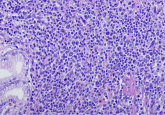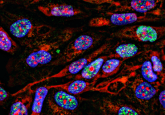A 2Phatal method for killing cells

Researchers have developed a two-photon-based method for killing targeted single cells in living animals.

Cell ablation is a key tool for studying the roles of cells in various biological phenomena, but a major problem has been the difficulty in killing single cells in complex living organisms. To accomplish this requires a technique for inducing apoptosis in specific cells without causing collateral damage to the surrounding non-target cells.
Now, researchers led by Jaime Grutzendler at the Yale School of Medicine have developed such a method, which they named two-photon chemical apoptotic targeted ablation (2Phatal). Their approach uses the focused illumination of a femtosecond-pulsed laser to induce two-photon-mediated photobleaching of the cell-permeant nuclear-binding dye Hoechst 33342 (H33342) in a single cell. This leads to apoptosis of the cell, presumably due to DNA damage caused by the reactive oxygen species (ROS) generated by photobleaching H33342 in the nucleus.
H33342 is crucial for 2Phatal, since the two-photon laser illumination of fluorescent proteins and a fluorescent dye proved to be ineffective for inducing single-cell apoptosis even though those have worked for in vitro cell ablation via laser photobleaching.
Grutzendler’s team demonstrated their method by administering H33342 intravenously or by topical application to the cortex through a cranial window in live mice, which resulted in extensive labeling of the nuclei in neurons and astrocytes. There was no cellular toxicity caused by the dye, and it was cleared from the tissue in days.
Two-photon laser illumination of a single labeled cell to photobleach the nuclear H33342 clearly induced the standard sequence of apoptotic events such as chromatin condensation and nuclear fragmentation, and did not rupture the cell nor damage adjacent axons. When the team ablated a specific type of interneuron in a particular neuronal circuit in the mouse brain, they observed that the spontaneous activity of the remaining neurons in the circuit was altered.
The team also applied the method in zebrafish to kill a specific type of mechanosensory cell in the lateral line organ of zebrafish that is similar to mammalian inner hair cells, indicating that 2Phatal will be a powerful and flexible approach for single-cell ablation in live animals of various species.





